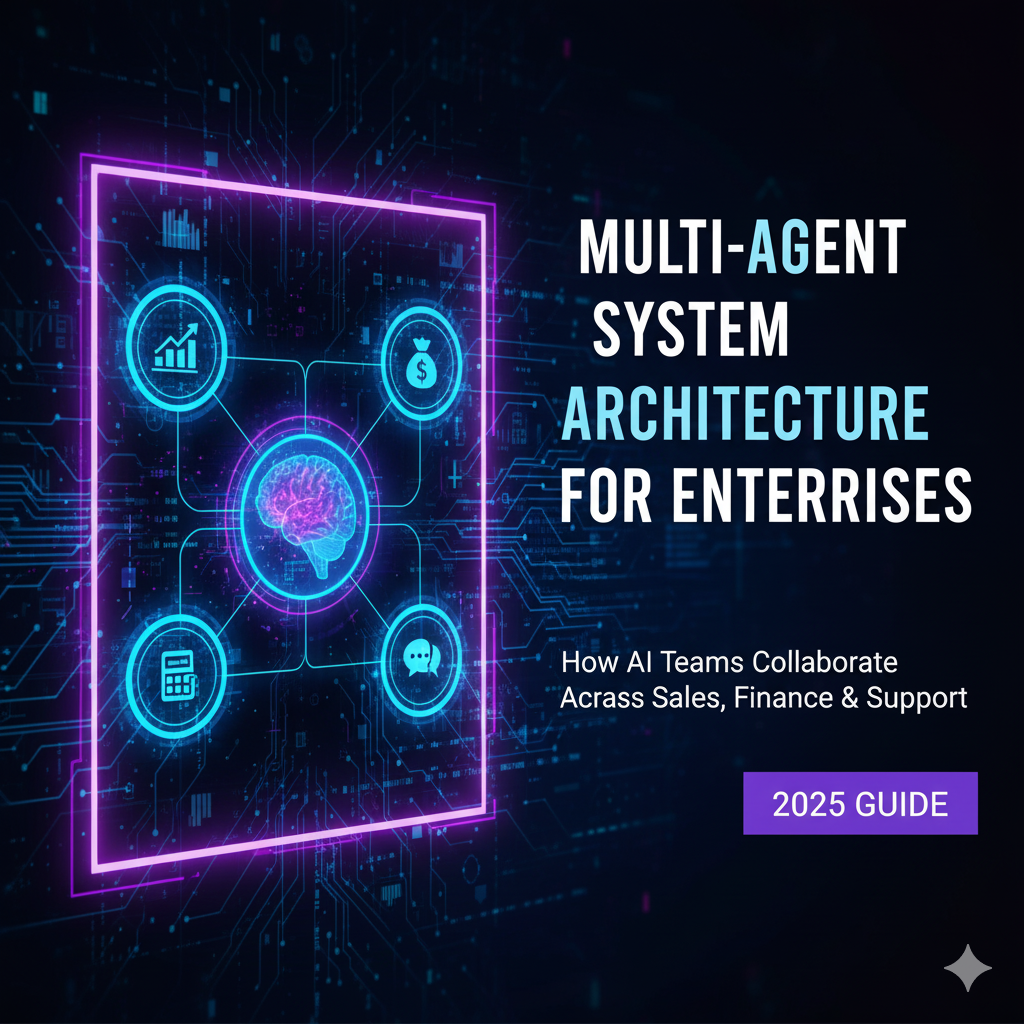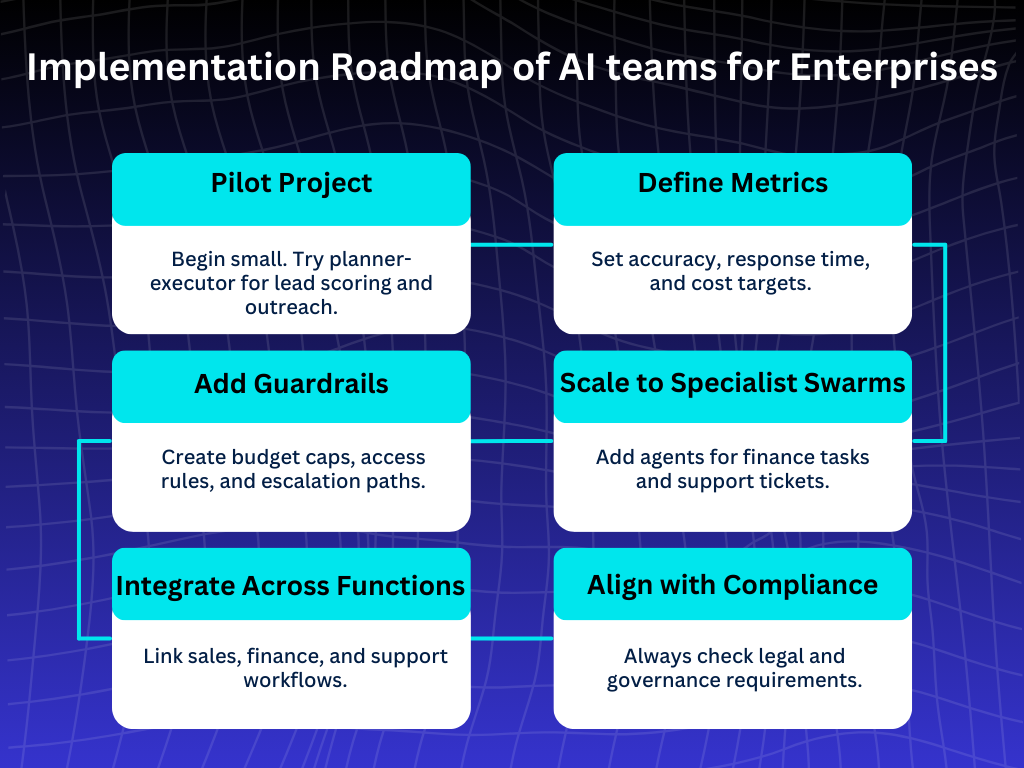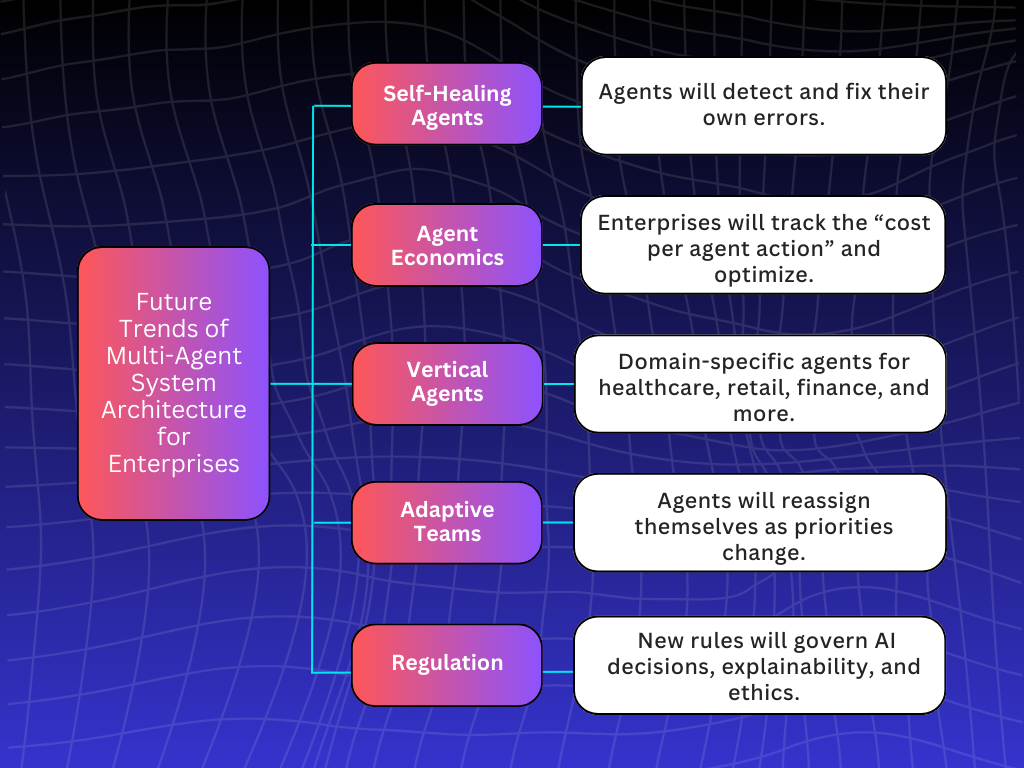
Multi Agent System Architecture for Enterprises: How AI Teams Collaborate Across Sales, Finance & Support?

Enterprises in 2025 don’t look the same as they did even a few years ago. Automation has grown up. It’s no longer about a single chatbot on a website or one smart tool running in the background. Now, businesses are turning to teams of AI agents that work together the way human teams do. This approach is known as multi-agent system architecture.
Here’s how it works. Instead of one system trying to do everything, different AI agents handle different roles. One agent plans, another executes, a third checks the results, and others handle smaller specialized tasks. Put together, they create a kind of digital workforce that supports sales, finance, and customer service all at once.
So why is this moment — 2025 — so important? Because agentic AI is finally mature enough to be rolled out at scale. Enterprises are adopting it fast because they want more speed, smarter cost control, and dependable automation across their operations.
In this blog, we’ll break down the key patterns behind multi-agent systems. You’ll see how sales, finance, and support teams work better when AI agents pass tasks back and forth. We’ll also look at the guardrails, SLAs, and monitoring practices that keep everything safe and reliable.
Introduction to Multi-Agent Systems
Multi-agent systems are at the heart of modern enterprise automation, bringing together multiple agents to tackle complex tasks that would overwhelm a single agent. In these agent systems, each agent operates independently but collaborates with others to achieve shared objectives.
This approach allows organizations to solve problems that are too intricate or dynamic for one agent alone, making multi-agent systems a powerful tool for real world applications.
By leveraging the strengths of individual agents, multi-agent systems can adapt to changing environments, learn from experience, and respond to new challenges as they arise. Whether it’s optimizing logistics, managing financial transactions, or streamlining customer support, these systems are designed to solve complex problems efficiently.
Their flexibility and scalability make them ideal for enterprises looking to automate and coordinate a wide range of tasks across different domains.
Key Concepts & Terminology
Before we dive deeper, let’s clear up some terms.
1. Multi-agent vs. monolithic systems
- A monolithic AI tries to do everything in one model. It can be slow, rigid, and hard to update.
- A multi-agent system splits tasks into smaller agents. Each agent is focused, faster, and easier to replace.
2. Autonomy: Agents act without constant human input. They can decide and take steps on their own.
3. Specialization: Every agent has a role. Some are good at writing emails. Others excel at analyzing data.
4. Coordination: Agents do not work in isolation. They share data, trigger actions, and complete workflows together.
5. Guardrails: Rules that keep agents safe. Guardrails stop overspending, data leaks, or incorrect actions.
6. SLAs: Service-level agreements define performance standards. For AI agents, this means response time, accuracy rate, or escalation steps.
7. Observability: You must be able to see what agents are doing. Logging, tracing, and monitoring keep actions transparent.
Advantages of Multi-Agent Systems
The benefits of multi-agent systems go far beyond what single agent systems can offer. By dividing complex tasks into manageable sub-tasks, multiple agents can work in parallel, dramatically speeding up problem-solving and increasing overall efficiency.
This division of labor means that even if one agent encounters an issue, other agents can continue to operate, making the system more robust and fault-tolerant.
Another key advantage is adaptability. Multi-agent systems can adjust to new information and changing environments, learning from experience to improve their performance over time. This makes them especially valuable in dynamic enterprise settings where requirements and data can shift rapidly.
The use of individual agents also allows for specialized expertise, so each agent can focus on what it does best, further enhancing the system’s ability to solve problems that would be too complex for a single agent to handle alone.
Common Multi-Agent Patterns
Now let’s explore the patterns enterprises use most.
1. Planner-Executor
Think of this as strategy vs. action.
- The planner agent decides what needs to be done.
- The executor agent follows the plan.
Example: In sales, the planner decides which leads to the target. The executor sends the outreach emails.
2. Critic-Refiner
This is a feedback loop.
- The critic checks the work.
- The refiner improves it.
Example: In finance, the critic reviews expense reports for errors. The refiner corrects them automatically.
3. Specialist Swarms
This is like a hive of workers.
- Many niche agents work in parallel.
- Each does a small job, fast.
Example: In customer support, one agent drafts responses, another checks tone, another fetches account data. Together they resolve tickets quickly.
Hybrid Models
Enterprises often mix these patterns. A planner-executor pair may hand work to a specialist swarm. Or a critic-refiner loop may oversee all outputs.
Cross-Functional Collaboration in Enterprises
The power of multi agent system architecture for enterprises shows up when agents cross departments.
1. Mapping Agents
- Sales: lead scoring, outreach, proposal generation.
- Finance: invoicing, payments, compliance checks.
- Support: ticket triage, responses, escalations.
Example Workflow
- A sales agent finds a lead.
- A finance agent generates a quote and checks payment history.
- A support agent prepares onboarding guidance once the deal closes.
2. Smooth Handoffs
Agents hand off work like humans passing tasks. Guardrails ensure data flows correctly. SLAs ensure nothing gets stuck.
3. Communication
Agents can communicate in several ways:
- Message passing (direct signals).
- Event bus (shared event streams).
- Shared memory (common database).
This makes collaboration seamless.
Architecture Components & Infrastructure
To make multi-agent systems work, enterprises need strong infrastructure.
1. Orchestration Layer
Think of the orchestration layer as the manager of your AI team. Most people know it assigns tasks. But here’s what many don’t realize: in 2025, orchestration is adaptive. It can reshuffle tasks when priorities shift.
For example, if a sales lead becomes urgent, orchestration can pull finance and support agents in right away. Also, it spots idle agents and reuses them elsewhere, saving compute costs. Another surprise? Orchestration now comes with built-in compliance checks.
2. Communication Protocols
We know agents must talk. But here’s the fun part: in 2025, they talk in ways humans don’t even notice. Most think it’s just APIs or messages. Yet, modern protocols support multimodal chats. For example, a support agent can share screenshots with a finance agent, not just text.
Also, many enterprises use event-driven buses that let agents listen in and react instantly. Few know that latency is now measured in milliseconds, agents pass info faster than humans can type. Even cooler, some new peer-to-peer protocols let agents talk directly without a hub. This makes teamwork faster and more natural.
3. Data Store and Memory
Memory makes agents feel less like “tools” and more like teammates. Most people know they use vector databases. But what’s new in 2025 is context-aware memory. Agents don’t just remember everything—they remember what matters right now.
For example, a sales agent recalls a client’s last email but forgets old details after 90 days. Also, memory layers are split: short-term for active tasks, long-term for strategy.
Here’s a hidden gem: enterprises now give agents “forgetting policies.” This keeps memory lean, avoids legal risks, and improves speed. So memory is less about hoarding and more about being sharp and useful.
4. Observability Stack
Everyone says “observability means logs.” True, but it’s now way more. In 2025, observability tools track not just what agents did, but why. For example, decision provenance shows which data influenced a quote or support reply. Few people know enterprises can replay an agent’s steps like a DVR, catching hidden errors.
Also, anomaly detection alerts you if an agent drifts from expected behavior. Another surprise? Observability now includes cost traces. You can see how much each agent action costs in dollars. That helps leaders budget better.
5. Guardrails
Guardrails are rules, yes, but they’re smarter now. For example, if a finance agent sees a big payment, stricter checks kick in. People don’t always know guardrails also monitor tone. Support agents get nudged if their response sounds too harsh.
Some guardrails are invisible. They silently filter out sensitive data before it even reaches the agent. And here’s something cool: modern guardrails test themselves. They simulate “what if” cases and update rules. So guardrails today act like co-pilots, quietly keeping everything safe and smooth.
6. SLAs
Most think of SLAs as boring contracts. But in 2025, they are living guardrails for agents. For example, instead of saying “reply in 10 minutes,” an SLA might say “reply fast and polite, 95% of the time.” Few know that sentiment scores and accuracy rates are now part of SLAs. They’re tracked in real time.
If an SLA is close to failing, the system can pull in backup agents or escalate to humans instantly. Another hidden detail: SLAs now measure cost too. Enterprises set budgets per task. That way, SLAs protect both performance and money.
Designing Effective Systems
Building effective multi-agent systems requires thoughtful design around how agents coordinate, communicate, and are controlled. Agent coordination is essential to ensure that all agents are working towards the same goal without duplicating efforts or causing conflicts. Techniques like auctions, voting systems, or shared protocols can help align agent actions and priorities.
Agent communication is another cornerstone—agents need reliable ways to share information, update each other on progress, and synchronize their activities. This can involve direct messaging, shared data stores, or event-driven architectures. Control mechanisms define how agents interact with each other and their environment, setting the rules for collaboration and decision-making.
Choosing the right tools and development platforms is also crucial, as these provide the foundation for building scalable, efficient, and maintainable multi-agent systems that can grow with enterprise needs.
Overcoming Complexity
As enterprises scale up their use of multi-agent systems, managing complexity becomes a central challenge. The more agents involved, the more intricate the interactions and dependencies become. To keep things manageable, developers often use modular design—breaking the system into smaller, independent modules that can be developed and tested separately. This makes it easier to isolate issues and update components without disrupting the entire system.
Hierarchical control is another effective strategy, where agents are organized in layers, with higher-level agents overseeing groups of lower-level agents. This structure helps maintain order and clarity as the system grows.
Distributed processing allows agents to run on multiple machines or processors, enabling parallel execution and faster problem-solving. By combining these approaches with artificial intelligence and machine learning, agent systems can learn from experience, adapt to new situations, and handle even the most complex tasks. This makes building multi-agent systems not only feasible but also highly effective for modern enterprises facing ever-evolving challenges.
Failure Modes & Risks
Like any system, multi-agent architectures can fail.
- Coordination Failures: Agents may talk past each other or duplicate tasks.
- Deadlocks: Two agents wait for each other, and nothing moves.
- Drift: Agents slowly make errors due to bad data.
- Hallucinations: Agents generate false or misleading content.
- Bottlenecks: If one agent is slow, the whole chain slows.
- Cascading Errors: A mistake in sales data may flow into finance and support.
- Security Risks: Without guardrails, sensitive data could leak.
- Mitigation: Use fallback agents, regular audits, and safe modes. Have humans in the loop for critical decisions.
Implementation Roadmap for Enterprises
How should you start?

- Pilot Project
Begin small. Try planner-executor for lead scoring and outreach. - Define Metrics
Set accuracy, response time, and cost targets. - Add Guardrails
Create budget caps, access rules, and escalation paths. - Scale to Specialist Swarms
Add agents for finance tasks and support tickets. - Integrate Across Functions
Link sales, finance, and support workflows. - Align with Compliance
Always check legal and governance requirements.
Case Studies & Examples
Example 1: Sales to Support
A SaaS company uses a planner agent to rank leads. The executor sends outreach. Once the lead converts, a finance agent creates the invoice. A support swarm handles onboarding. Result: faster revenue recognition and happier customers.
Example 2: Finance Automation
A large bank uses critic-refiner loops to review transactions. Suspicious items are flagged. A human only reviews high-risk cases. Result: fraud detection improved with fewer false positives.
Example 3: Customer Support
An e-commerce firm uses a swarm of support agents. One drafts answers, another checks product data, a third refines tone. Tickets close 40% faster.
Lessons learned: multi-agent systems work best with clear roles, observability, and human oversight.
Future Trends
Looking ahead, we see exciting trends.

- Self-Healing Agents
Agents will detect and fix their own errors.
- Agent Economics
Enterprises will track the “cost per agent action” and optimize.
- Vertical Agents
Domain-specific agents for healthcare, retail, finance, and more.
- Adaptive Teams
Agents will reassign themselves as priorities change.
- Regulation
New rules will govern AI decisions, explainability, and ethics.
Conclusion
The age of multi-agent AI has arrived. Multi agent system architecture for enterprises is no longer theory. It is how modern businesses run.
By using planner-executor pairs, critic-refiner loops, and specialist swarms, enterprises can automate sales, finance, and support at scale. Smooth handoffs, guardrails, and SLAs ensure reliability. Observability and governance keep trust high.
The journey starts small, with one pilot, and grows into full enterprise transformation. The companies that adopt early gain speed, savings, and stronger customer relationships.
It is time to pilot, monitor, and scale with confidence. The future of enterprise AI is multi-agent, and it is already here.

Transform Your Business With Agentic Automation
Agentic automation is the rising star posied to overtake RPA and bring about a new wave of intelligent automation. Explore the core concepts of agentic automation, how it works, real-life examples and strategies for a successful implementation in this ebook.
More insights
Discover the latest trends, best practices, and expert opinions that can reshape your perspective
Contact us






.webp)





